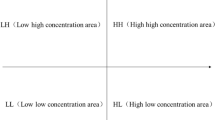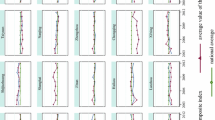Abstract
The Greater Beijing-Tianjin-Hebei Region has long been troubled with extremely unbalanced ecological progress, flawed industrial structure, heavy pollutant emissions and serious ecological deterioration, which have constrained its high-quality development. To build a world-class city cluster with the capital as its core, the Greater Beijing-Tianjin-Hebei Region must reduce pollutant emissions at the source through industrial adjustment, force industrial transformation and upgrading through pollution control, boost industrial adjustment through technological innovation, develop low-carbon new energy industry, build a coordinated ecological development mechanism, push forward structural reform on the supply side and improve industrial space balance and supporting services.
Access this chapter
Tax calculation will be finalised at checkout
Purchases are for personal use only
Similar content being viewed by others
Notes
- 1.
Rogerson J. M., Szymanska D., Green Commercial Property Development in Urban South Africa: Emerging Trends, Emerging Geographies, Bulletin of Geography. Socio-economic Series, 2014 (26): 233–246.
- 2.
Chen Hui. Reflections on the Development Theory of Modern World-class Cities. Sun Yat-sen University Forum, 2006 (10).
- 3.
Yu Hongsheng. Research on Shanghai City Cluster Matching with World-Class City Clusters. Scientific Development, 2009 (11).
- 4.
Yu Sijia, Zhang Yi and Wei Dong. Focus on the Development Opportunities of Yangtze River Delta to Build A World-Class City Cluster. Shanghai Urban Planning Review, 2009 (1).
- 5.
Feng Fengling and Liu Xiaomin. Research on the relations in the development of Beijing-Tianjin-Hebei world-class city cluster and the Xiong’an New Area. Modern Business, 2018 (12).
- 6.
Wang Fengyun and Ren Yaping. Research on the City Positioning of Guangdong-Hong Kong-Macao Greater Bay Area in the Construction of World-Class City Cluster. Shanghai Urban Planning Review, 2018 (2).
- 7.
Shen Kunrong and Zhao Qian. International Comparison of World-Class City Clusters and the Choice of Regional High-Quality Development Paths, Following the Example of Jiangsu Province. Jianghai Academic Journal, 2018 (2).
- 8.
Wang Liang and Shi Xiaodong. From City to Region: Reflections on Beijing’s Action on Building a World-Class City Cluster with the Capital as Its Core. Beijing Planning Review, 2018 (1).
- 9.
Zhou Wei and Cai Pei. Research on Greater Beijing-Tianjin-Hebei Region Industrial Restructuring Paths. Journal of Commercial Economics, 2016 (2).
- 10.
Song Haiouand Wang Ying. Beijing-Tianjin-Hebei Coordinated Development: Industrial Restructuring and Air Pollution Prevention and Control. Chinese Journal of Population, Resources and Environment, 2016 (26).
- 11.
2017 Hebei Province National Economic and Social Development Statistics Communiqué, http://110.249.220.86/hetj/app/tjgb/101517369076975.html.
- 12.
Liu Shuhua and Miao Yucong. Causes and Control of Smog in Greater Beijing-Tianjin-Hebei Region. China Economic Report, 2017 (2).
- 13.
Liu Junqing. How Heavily-Polluting Hebei Province’s Heavy Chemical Industry Is. Chinese Economy & Information Technology, 2013 (19).
- 14.
2017 China Greater Beijing-Tianjin-Hebei Region Coal Pollution Problem and Alternative Space Analysis, http://www.chyxx.com/industry/201707/542482.html.
- 15.
Expert Speaking on the Pollution in Greater Beijing-Tianjin-Hebei Region and Its Surrounding Areas on 16–19, 2018, http://www.zhb.gov.cn/gkml/sthjbgw/qt/201804/t20180420_435081.htm.
- 16.
Li Chunsheng. Research on Industrial Restructuring in the Greater Beijing-Tianjin-Hebei Region Coordinated Development. Enterprise Economy, 2015 (8).
References
Beijing Municipal Bureau of Statistics and Survey Office of the National Bureau of Statistics in Beijing. (2018). Beijing Statistical Yearbook 2018. Beijing: China Statistics Press.
Chen Hui. Reflections on the Development Theory of Modern World-class Cities. Sun Yat-sen University Forum, 2006 (10).
Diwakar J., Thakur J. K. Environmental System Analysis for River Pollution Control. Water Air & Soil Pollution, 2012 (223).
Feng Fengling and Liu Xiaomin. Research on the relations in the development of Greater Beijing-Tianjin-Hebei Region world-class city cluster and the Xiongan New Area. Modern Business, 2018 (12).
Rogerson J. M., Szymanska D. Green Commercial Property Development in Urban South Africa: Emerging Trends, Emerging Geographies, Bulletin of Geography. Socio-economic Series, 2014 (26).
Shen Kunrong and Zhao Qian. International Comparison of World-Class City Clusters and the Choice of Regional High-Quality Development Paths, Following the Example of Jiangsu Province. Jianghai Academic Journal, 2018 (2).
Song Haiou and Wang Ying. Greater Beijing-Tianjin-Hebei Region Coordinated Development: Industrial Restructuring and Air Pollution Prevention and Control. Chinese Journal of Population, Resources and Environment, 2016 (26).
Wang Fengyun and Ren Yaping. Research on the City Positioning of Guangdong-Hong Kong-Macao Greater Bay Area in the Construction of World-Class City Cluster. Shanghai Urban Planning Review, 2018 (2).
Wang Liang and Xiaodong Shi. From City to Region: Reflections on Beijing’s Action on Building a World-Class City Cluster with the Capital as Its Core. Beijing Planning Review, 2018 (1).
Zhou Wei and Cai Pei. Research on Greater Beijing-Tianjin-Hebei Region Industrial Restructuring Paths. Journal of Commercial Economics, 2016 (2).
Author information
Authors and Affiliations
Corresponding author
Editor information
Editors and Affiliations
Rights and permissions
Copyright information
© 2021 The Author(s)
About this chapter
Cite this chapter
Xiaocheng, L. (2021). A Study of Beijing-Tianjin-Hebei Industrial Adjustment and Pollution Control from the Perspective of World-Class City Cluster. In: Analysis of the Development of Beijing, 2019. Palgrave Macmillan, Singapore. https://doi.org/10.1007/978-981-15-6679-0_11
Download citation
DOI: https://doi.org/10.1007/978-981-15-6679-0_11
Published:
Publisher Name: Palgrave Macmillan, Singapore
Print ISBN: 978-981-15-6678-3
Online ISBN: 978-981-15-6679-0
eBook Packages: Political Science and International StudiesPolitical Science and International Studies (R0)




